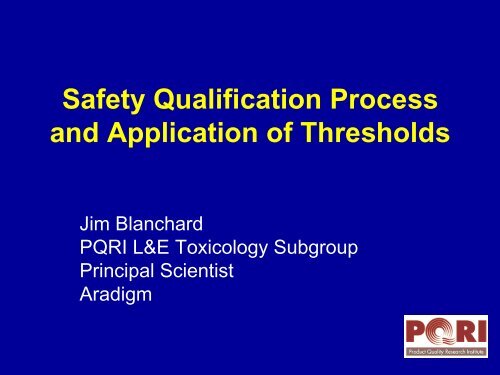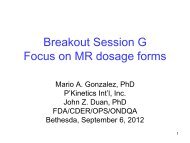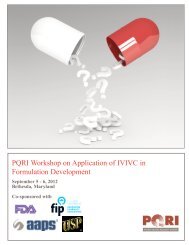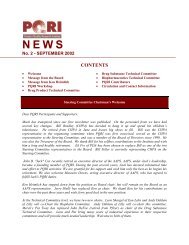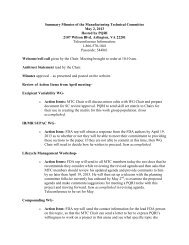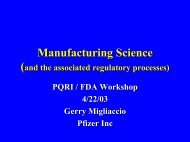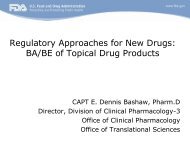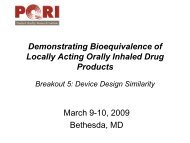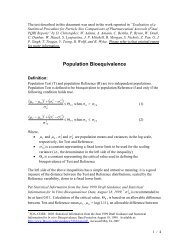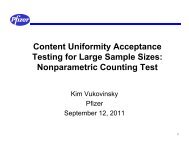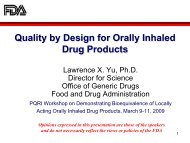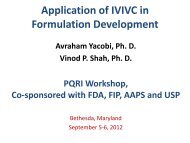Development and Justification of Qualification Threshold - PQRI
Development and Justification of Qualification Threshold - PQRI
Development and Justification of Qualification Threshold - PQRI
You also want an ePaper? Increase the reach of your titles
YUMPU automatically turns print PDFs into web optimized ePapers that Google loves.
Safety <strong>Qualification</strong> Process<br />
<strong>and</strong> Application <strong>of</strong> <strong>Threshold</strong>s<br />
Jim Blanchard<br />
<strong>PQRI</strong> L&E Toxicology Subgroup<br />
Principal Scientist<br />
Aradigm
Outline<br />
• Safety qualification process<br />
– What to do when leachables exceed:<br />
• Safety concern threshold (SCT)<br />
• <strong>Qualification</strong> threshold (QT)<br />
– Decision tree<br />
• Roles for risk assessment in OINDP<br />
development<br />
• Application <strong>of</strong> risk assessment <strong>and</strong> thresholds<br />
Slide 2
Leachable Safety <strong>Qualification</strong> Process<br />
Slide 3<br />
• Based on ICH Q3A <strong>and</strong> Q3B for impurities<br />
• When leachable ≤ SCT, then qualified<br />
• If leachable > SCT but ≤ QT, then options are:<br />
– Reduce leachable ≤ SCT or<br />
– Conduct risk assessment, then<br />
– Qualify leachable via assessment <strong>and</strong>/or testing, or<br />
– Propose higher acceptable level for leachable to FDA<br />
• If leachable > QT, then options are:<br />
– Reduce leachable ≤ QT or<br />
– Conduct risk assessment, then<br />
– Qualify leachable via assessment <strong>and</strong>/or testing, or<br />
– Propose higher acceptable level for leachable to FDA
Leachable Safety <strong>Qualification</strong> Process (2)<br />
• Using a higher or lower acceptable level for a<br />
leachable is an option based on scientific<br />
rationale, potency, <strong>and</strong> level <strong>of</strong> concern<br />
– Alternate acceptable levels may be proposed to FDA<br />
<strong>and</strong> treated on a case-by-case basis.<br />
• Lower acceptable levels are needed for<br />
compounds with special safety concerns, such<br />
as:<br />
– Nitrosamines<br />
– Polynuclear aromatics (PNA's)<br />
– Mercaptobenzothiazole<br />
– Such leachables considered on case-by-case basis<br />
Slide 4
<strong>Qualification</strong> <strong>of</strong> Leachables<br />
• <strong>Qualification</strong> steps considered “appropriate”<br />
depend on:<br />
– Patient population<br />
– Total daily intake (TDI)<br />
– Duration <strong>of</strong> drug administration<br />
• <strong>Qualification</strong> steps<br />
– Risk assessment<br />
• Structure-activity relationship (SAR) analysis<br />
• Literature review<br />
– Safety studies<br />
• Genotoxicity<br />
• General toxicity<br />
• Other, as needed<br />
Slide 5
<strong>Qualification</strong> <strong>of</strong> Leachables (2)<br />
• Safety studies can be conducted on:<br />
– OINDP containing the leachables to be<br />
controlled<br />
– Isolated leachables may be appropriate<br />
• Genotoxicity – minimum <strong>of</strong> two in vitro tests<br />
Slide 6<br />
– Point mutation<br />
– Chromosomal aberration
<strong>Qualification</strong> <strong>of</strong> Leachables (3)<br />
• General toxicity studies<br />
– Compare unqualified to qualified material<br />
– One relevant species<br />
– Duration<br />
• Usually 14 to 90 days<br />
• Single dose appropriate for single-dose drugs<br />
• Other specific toxicity endpoints, as appropriate<br />
Slide 7<br />
– Carcinogenicity studies may be needed for<br />
compounds with SAR alerts for carcinogenicity
<strong>Qualification</strong> <strong>of</strong> Leachables (4)<br />
• Role for USP <strong>and</strong> ISO Biocompatibility Tests<br />
Slide 8<br />
– United States Pharmacopoeia: USP <strong>and</strong> <br />
– International St<strong>and</strong>ards Organization: ISO 10993<br />
– Propose these tests may be appropriate for suppliers<br />
<strong>of</strong> OINDP device components<br />
– Drug product manufacturers need not perform these<br />
tests when a more comprehensive in-vivo<br />
toxicological evaluation is available.
Decision Tree
Roles <strong>of</strong> Risk Assessment in OINDP<br />
• Risk assessment tools<br />
– SAR analysis<br />
– Literature review<br />
<strong>Development</strong><br />
• Risk assessment to evaluate safety <strong>of</strong>:<br />
Slide 13<br />
– Components for container/closure system<br />
– Extractables from initial studies on components<br />
– Leachables with total daily intake (TDI) > SCT or QT
Risk Assessment: Component Selection<br />
• Preliminary risk assessment done on component<br />
formulations provided by suppliers<br />
– Evaluate in terms <strong>of</strong> potential extractables <strong>and</strong><br />
leachables<br />
• Allows for informed component selection early in<br />
development<br />
– Allows for early identification compounds <strong>of</strong> potential<br />
concern, thereby saving time <strong>and</strong> resources.<br />
• Involves collaboration among toxicologists,<br />
material scientists, <strong>and</strong> chemists<br />
Slide 14
Risk Assessment: Extractables<br />
• Preliminary risk assessment done on<br />
extractables from components<br />
• Confirms component selection<br />
• Involves collaboration between toxicologists <strong>and</strong><br />
chemists<br />
Slide 15
Risk Assessment: Leachables<br />
• Risk assessment on leachables with TDI > SCT<br />
or QT<br />
• Involves collaboration between toxicologists <strong>and</strong><br />
chemists<br />
Slide 16
Risk Assessment: Extractables/Leachables<br />
• Three steps:<br />
Slide 17<br />
1. Extractable/leachable identification information<br />
provided by chemist to toxicologist<br />
2. Preliminary risk assessment done by toxicologist<br />
3. If more rigorous risk assessment needed, then more<br />
detailed identification <strong>and</strong> dosage information<br />
should be requested by toxicologist from chemist
Application <strong>of</strong> Risk Assessment & <strong>Threshold</strong>s (1)<br />
• <strong>PQRI</strong> L&E Working Group undertook mock<br />
safety qualification to assess process<br />
• Performed risk assessment on extractables ><br />
AET<br />
– Extractables from elastomer<br />
– No leachable data were available<br />
• Risk assessment consisted <strong>of</strong> only SAR<br />
– Identified compounds with <strong>and</strong> without alerts<br />
• Assumed different TDIs for compounds<br />
• Using decision tree, applied thresholds to<br />
compounds with different toxicity pr<strong>of</strong>iles<br />
Slide 18
Application <strong>of</strong> Risk Assessment & <strong>Threshold</strong>s (2)<br />
• Extractable dataset<br />
Slide 19<br />
– Sulfur-cured elastomer extracted with<br />
methylene chloride<br />
• 66 total extractables > AET identified by GC/MS<br />
– 29 compounds with confirmed or confident<br />
structures<br />
• Confirmed: matched with reference st<strong>and</strong>ards<br />
• Confident: precluded all but most closely related<br />
compounds
Application <strong>of</strong> Risk Assessment & <strong>Threshold</strong>s (3)<br />
• SAR Analysis<br />
Slide 20<br />
– S<strong>of</strong>tware<br />
• DEREK (Pfizer) on 29 compounds<br />
• Multicase (FDA) on 26 compounds<br />
– Compared DEREK <strong>and</strong> Multicase results for<br />
26 compounds, based on:<br />
• Carcinogenicity<br />
• Mutagenicity<br />
• Skin sensitization
Application <strong>of</strong> Risk Assessment & <strong>Threshold</strong>s (4)<br />
SAR Results:<br />
Alert No Alert<br />
Both<br />
Alert Both Alert Alert Multicase<br />
DEREK Only Only<br />
Carcinogen 17 3 5 1<br />
Mutagen 25 1 0 0<br />
Skin Sensitizer 18 0 4 4<br />
Slide 21
Application <strong>of</strong> Risk Assessment & <strong>Threshold</strong>s (5)<br />
1. Risk assessment <strong>of</strong> leachables > SCT<br />
1. SAR<br />
2. Literature review <strong>of</strong> compounds with alerts<br />
2. Based on risk assessment, decide which<br />
compounds need further risk assessment<br />
3. Questions for chemist about compounds for<br />
further risk assessment:<br />
Slide 22<br />
1. Is level <strong>of</strong> structural information sufficient?<br />
2. What is TDI <strong>of</strong> leachable?
Application <strong>of</strong> Risk Assessment & <strong>Threshold</strong>s (6)<br />
1. Is level <strong>of</strong> structural information sufficient?<br />
Slide 23<br />
• Ideally leachables have “confirmed” structures<br />
• Based on comparison with reference st<strong>and</strong>ards<br />
• If only “confident” or “tentative” structures, then ask<br />
chemist for best identification information possible<br />
• If new information provides new structure, then rerun<br />
SAR analysis <strong>and</strong> literature review
Application <strong>of</strong> Risk Assessment & <strong>Threshold</strong>s (7)<br />
2. What is the total daily intake (TDI) <strong>of</strong><br />
leachable?<br />
Slide 24<br />
• Request information from chemist on:<br />
• Concentration <strong>of</strong> the leachable in drug product<br />
• Drug product dosage<br />
• Drug product potency
Application <strong>of</strong> Risk Assessment & <strong>Threshold</strong>s (7)<br />
• Further safety assessment is based on<br />
application <strong>of</strong> SCT <strong>and</strong> QT in decision tree<br />
• The proposed specification for leachable in<br />
drug product, the risk assessment <strong>and</strong> other<br />
supporting data should be submitted to FDA,<br />
which may:<br />
– Accept proposed specification for leachable<br />
– Ask for further qualification<br />
– Establish alternate acceptable level for leachable<br />
Slide 25
Application <strong>of</strong> Risk Assessment & <strong>Threshold</strong>s (8)<br />
• Example #1: 2-chloro-methyl- thiobenzothiazole<br />
– Potential carcinogen based on SAR alert <strong>and</strong> literature<br />
– Patient TDI between SCT <strong>and</strong> QT<br />
• Options are:<br />
– Reduce leachable ≤ SCT or<br />
– Conduct risk assessment <strong>and</strong> submit to FDA, then<br />
– Propose higher acceptable level for leachable to FDA,<br />
or<br />
– Qualify leachable via:<br />
• Risk assessment<br />
• Safety studies <strong>of</strong> carcinogenicity in addition to genotoxicity <strong>and</strong><br />
general toxicity<br />
• Submit risk assessment <strong>and</strong> supporting data to FDA for<br />
concurrence or a request for further qualification<br />
Slide 26
Application <strong>of</strong> Risk Assessment & <strong>Threshold</strong>s (9)<br />
• Example #2: Ethyl-4-ter-butyl phenyl ether<br />
– No SAR alert for carcinogenicity, mutagenicity, or<br />
sensitization<br />
– Patient TDI > QT<br />
• Options are:<br />
– Reduce leachable ≤ QT or<br />
– Conduct risk assessment <strong>and</strong> submit to FDA, then<br />
– Propose higher acceptable level for leachable to FDA<br />
or<br />
– Qualify leachable via:<br />
• Risk assessment<br />
• Safety studies <strong>of</strong> genotoxicity <strong>and</strong> general toxicity<br />
• Submit risk assessment <strong>and</strong> supporting data to FDA for<br />
concurrence or a request for further qualification<br />
Slide 27
Summary<br />
• Safety qualification process provides clear<br />
guidelines <strong>and</strong> options for leachables based on:<br />
– Leachable toxicity properties<br />
– Patient total daily intake (TDI)<br />
• Risk assessment is needed for:<br />
– Component selection<br />
– Assessment <strong>of</strong> extractables<br />
– Assessment <strong>of</strong> leachables<br />
• Toxicologists, chemists, <strong>and</strong> material scientists<br />
should collaborate from the start <strong>of</strong> development<br />
– Allows for early identification <strong>of</strong> compounds <strong>of</strong><br />
potential concern, thereby saving time <strong>and</strong> resources.<br />
Slide 28


